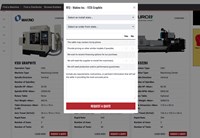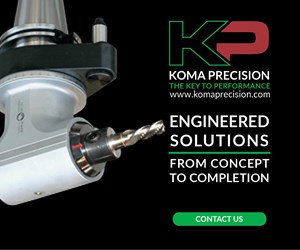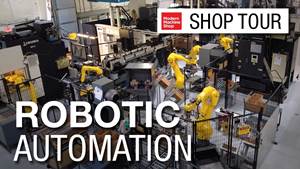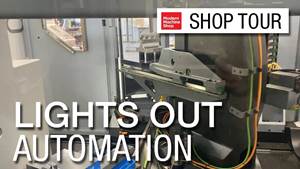How Modal Testing Can Reveal Dynamic Machining Responses
Tool-holder-spindle-machine combinations each have a unique dynamic response in the same way that each person has a unique fingerprint, which can be revealed using modal testing.
Share
The digital manufacturing process begins with a part design that is represented by a digital, three-dimensional model. When machining is the manufacturing process, the model dimensions, tolerances and materials inform decisions on workpiece stock, cutting tool and toolholder, machining center, workholder and coolant. The CAM step uses the part and stock models, as well as the selected cutting tools, to generate toolpaths that remove material and reveal the desired geometry. This sequence of events suggests that machining is a fully geometric process.
While geometry is important, machining is more than geometry. When selecting the CAM parameters, including step over (radial depth of cut), step down (axial depth) and spindle speed, the dynamic response of the toolholder-spindle-machine combination, and sometimes the workpiece, must be considered. This is due to the vibrations that occur during machining, which can be characterized as forced vibration and self-excited vibration.
In forced vibration, the cutting force and corresponding vibration repeat from one tooth to the next, providing a consistent surface finish. In self-excited vibration, the inherent feedback mechanism in machining causes the process to become unstable, which is referred to as chatter. The feedback mechanism is possible because the tool vibration is imprinted on the workpiece surface, causing chip thickness to vary from one tooth to the next. This represents “memory” in the machining process. The variable chip thickness leads to a variable force which, in turn, affects the current vibration. Whether we obtain forced vibration (good vibration) or chatter (bad vibration) depends on the spindle speed-depth of cut combination and the toolholder-spindle-machine dynamics.
So… how do we know which combinations cause chatter and which do not? The required information is contained in the frequency response function, or FRF. This describes the vibration response divided by the force input in the frequency domain. With the FRF, we can identify the natural frequency, stiffness and damping for each vibration mode.
To measure the FRF, we use modal testing, also referred to as tap testing. The figure above identifies the key elements of the test. The lower left photograph shows a modal hammer being used to tap a tool tip and an accelerometer being used to measure the vibration response. The top row displays the time responses for the force and vibration. We see that the tap produces a short duration force input. Due to this impulse, the tool vibrates with a decaying amplitude (due to damping).
The middle row shows the conversion of these signals to the frequency domain. The bottom row displays the FRF. As stated, we can identify the natural frequency, stiffness and damping for each vibration mode (only a single mode is shown in this example). The value of this information is that we can use it to generate a stability map that separates spindle speed-depth of cut combinations that produce chatter from those that do not. When this information is available at the process planning stage, the test-and-check approach of confirming part programs can be reduced or eliminated. In this way, we move the “fingerprint” of the toolholder-spindle machine into the digital environment and make digital manufacturing possible.
Related Content
Custom Motorcycle Parts Made Here: Video Tour of a Family-Owned CNC Machine Shop
Lee Wimmer invited us to tour his second-generation family-owned machine shop in Perkasie, PA. This video explores the production processes behind precision-machined parts for both Wimmer Custom Cycle and LS Wimmer Machine Co., and shows how ingenuity and determination are still at the heart of American manufacturing. Today, both companies are now managed by Wimmer’s three sons.
Read MoreWorkholding Increases a CNC Shop’s Efficiency
Rimeco Products, Inc. is a family owned CNC Machine Shop located outside of Cleveland, Ohio. Cleveland is known for manufacturing, with a lot of large OEM’s located in and around the city. Rimeco specializes in aerospace and defense products. Their experience, has led the to create in-house machining solutions to maximize efficiency.
Read MoreMetalQuest - Robotic Automation of a Machine Shop
Robots have helped MetalQuest stay competitive and deal with the skills gap. See how they have integrated high-level automation into all aspects of their shop.
Read MoreLights Out Machining With An Automated 5-Axis Cell
Legacy Precision Molds takes us on a tour of their moldbuilding facility. They've recently implemented two automated 5-axis cells for metal and graphite machining that run lights out during nights and weekends.
Read MoreRead Next
IMTS 2024: Trends & Takeaways From the Modern Machine Shop Editorial Team
The Modern Machine Shop editorial team highlights their takeaways from IMTS 2024 in a video recap.
Read MoreInside Machineosaurus: Unique Job Shop with Dinosaur-Named CNC Machines, Four-Day Workweek & High-Precision Machining
Take a tour of Machineosaurus, a Massachusetts machine shop where every CNC machine is named after a dinosaur!
Read MoreThe Future of High Feed Milling in Modern Manufacturing
Achieve higher metal removal rates and enhanced predictability with ISCAR’s advanced high-feed milling tools — optimized for today’s competitive global market.
Read More













.jpg;maxWidth=300;quality=90)












